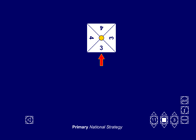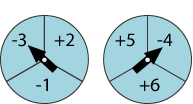Consolidation and practice
These resources are to support children in guided or independent work. Roll over the highlighted resource for a description.
Number spinners

This interactive teaching program (ITP) is an ICT-based tool to support the exploration of number, reasoning and problem solving. Number spinners ITP allows the child or teacher to generate 3, 4, 5 or 6 random numbers on up to 3 spinners. Numbers from 0 to 99 can be displayed.
Opportunities to use and apply
Possible contexts include:
- Devising games, e.g. Make up rules for a simplified lottery game – only numbers 1 to 3 are available and you can pick two numbers. How many possible outcomes are there? Can you devise a game where there are 12 possible outcomes?
- Dice experiments, e.g. Throw two (or three) dice and find the total, identifying all the possible outcomes for the experiment.
- Spinner and card experiments, e.g. Design an experiment using two different spinners and identifying the possible outcomes.
Confirming learning
Ask probing questions such as:
- A door has a security lock. To open the door you must press the correct buttons. The code for the door is a letter followed by a single digit number, for example B6.
How many different codes are there altogether?
Explain how you are sure you have found all possibilities.
Can you design a code that is harder to crack? How many different combinations does your code have?

- These two spinners are spun at the same time.
The two scores are added together. Record all the possible outcomes.
Design two spinners that would give fewer possible outcomes for the experiment.

 Handling data
Handling data


